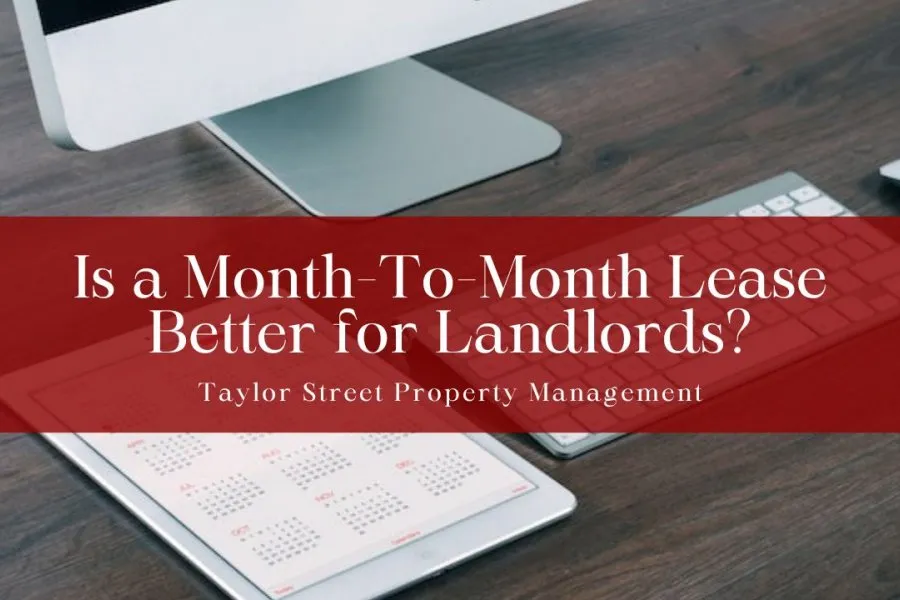Requiring tenants to sign a lease or a rental agreement prior to moving into your rental property is key. A detailed agreement will help you communicate the expectations you have to your tenant clearly and concisely.
Whether you’re new to the business or have years of experience renting properties, you might be wondering what type of lease agreement to go for with each new potential tenant. Today’s blog will help you answer the question: Is a month-to-month lease better for landlords than a long-term lease agreement?
What Is a Month-to-Month Lease?
A month-to-month lease is a type of short-term lease agreement. It runs periodically (month to month) for an unspecified period of time. Either party—landlord or tenant—can terminate it at any point by serving the other a proper notice. In Arizona, you’ll need to serve your tenant a notice of at least 30 days to terminate their lease.
Typically, landlords use month-to-month leases to extend an existing fixed-term lease. This helps eliminate potential holdover issues.
What Are the Pros of Having a Month-to-Month Lease?
The topmost advantage of having a month-to-month lease is the flexibility that comes with it. You’re able to determine the kind of tenant you rent to and for how long, or use it after a fixed-term agreement ends to give a tenant more time to find their next apartment.
The following are the situations in which a month-to-month lease would be ideal.
1. The End Date Is Flexible

Ending a month-to-month lease is easy and flexible for both you and your tenant. If you no longer want to rent to the tenant, you’ll only need to serve them with a 30 days’ advance notice to end their tenancy. The same applies to your tenant. To move out, all they need to serve you is a 30 days’ advance notice.
2. You Can Test the Waters
If you’re renting out your home for the first time, a month-to-month lease may be the best option for you. It’ll help you test your systems to know whether or not they are effective. An example would be your tenant screening process. You’ll be able to test how solid it is by the kind of tenants you rent to.
3. You May Be Able to Raise Rent Easily
Unlike a fixed-term agreement, a month-to-month lease can help you raise rent easily, as you’d only need to wait until the next cycle to raise it. Since the state of Arizona doesn’t have provisions for rent control, you may be able to set rental prices as high as you wish.
That being said, it’s important to charge tenants a reasonable rent price. Overcharging tenants could make your unit less desirable, leading to extended vacancies. Consider the best ways to price your rental property.

4. There Are No Penalties for Breaking the Lease Early
Ending a fixed-term lease often attracts penalties, especially if the reason is legally unjustified. This isn’t the case with short-term leases.
With a short-term lease, it’s expected that either party will terminate it at some point. Some landlords usually prefer doing so over the summer, as rental demand is usually higher.
5. You Can Maintain Quality Tenants
The goal of every landlord is to rent to quality tenants. Quality tenants pay rent on time, care for the rented property, and abide by all terms of the lease agreement. Having such a tenant will help maximize your return on investment.
Since you’re not bound by any long-term commitments, a month-to-month lease can help you find great tenants—and extend their lease with you until they eventually leave.
What Are the Cons of Having a Month-To-Month Lease?
Month-to-month leases may come with their share of cons. The following are some reasons that make month-to-month leases unattractive to some landlords.
1. The End Date Is Uncertain
As already mentioned, month-to-month leases offer some level of flexibility. For instance, you’re easily able to terminate the lease of a tenant. However, this level of flexibility may also work against you. Renting your property on a short-term basis may have a detrimental impact on your bottom line.
2. You Have Short Notice to Find New Tenants

Finding a new tenant with a 30 days’ notice may be insufficient. Operating on a time crunch could end up putting more pressure on you to find a tenant, potentially compromising the quality of the tenant you rent to.
3. The Income May Not Be Stable
This is another shortcoming that comes with renting a property on a short-term basis. If you’re not able to hold on to a tenant for long, your bottom line could suffer.
What Is the Difference between a Month-to-Month Lease and a Fixed-Term Lease?
A fixed-term lease (or fixed-term tenancy) is just that—a lease that stretches over a fixed period of time, usually between 6 months and a year. Either party must wait for the lease to run its entire course to make any changes to the agreement, such as raising the rent amount.
Terminating a fixed-term agreement can be more complicated than ending a month-to-month lease. There may be legal and/or financial ramifications for doing so.
Conclusion
So, is a month-to-month lease better for landlords? There’s no straightforward answer! Consider your circumstances and examine the pros and cons to see what option is best for you.
For expert help in managing your Phoenix rental property, contact Taylor Street Property Management. We have the necessary experience and resources to help you grow and maximize your return on investment!


